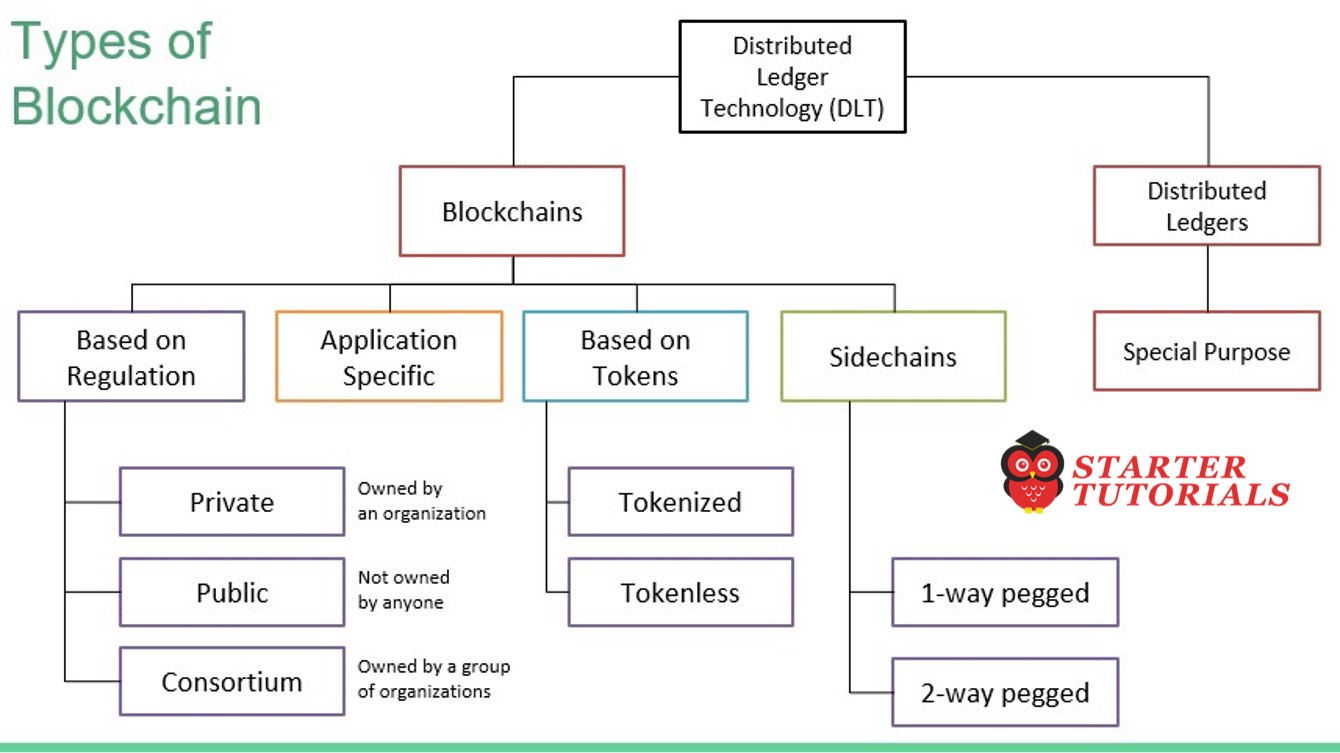In this article we will discuss different types of blockchain based on its evolution and usage. The categorization of blockchains is illustrated in the figure below:
Contents
Distributed Ledgers
A distributed ledger is a shared database. All blockchains technically fall under distributed ledgers. But, all distributed ledgers are not blockchains. A critical difference between a distributed ledger and a blockchain is that a distributed ledger does not necessarily consist of blocks of transactions to keep the ledger growing. Rather, a blockchain is a special type of shared database that is composed of blocks of transactions.
As the name suggests, a distributed ledger is distributed among its participants and spread across multiple sites or organizations. This type of ledger can be either private or public. The fundamental idea here is that, unlike many other blockchains, the records are stored contiguously instead of being sorted into blocks.
Distributed Ledger Technology
It should be noted that over the last few years, the terms distributed ledger or DLT have grown to be commonly used to describe blockchain in the finance industry. Although they are used interchangeably, they are not same.
From a financial sector point of view, DLTs are permissioned blockchains that are used by consortiums. DLTs usually serve as a shared database, with all participants known and verified. They do not have a cryptocurrency and do not require mining to secure the ledger.
Public Blockchains
As the name suggests, public blockchains are not owned by anyone. They are open to the public, and anyone can participate as a node in the decision-making process. Users may or may not be rewarded for their participation.
All users of these “permissionless” or “un-permissioned” ledgers maintain a copy of the ledger on their local nodes and use a distributed consensus mechanism to decide the eventual state of the ledger. Bitcoin and Ethereum are both considered public blockchains.
Private Blockchains
Private blockchains are open only to a consortium or group of individuals or organizations who have decided to share the ledger among themselves. There are various blockchains now available in this category, such as Kadena and Quorum. Optionally, both of these blockchains can also run in public mode if required, but their primary purpose is to provide a private blockchain.
Semi-Private Blockchains
With semi-private blockchains, part of the blockchain is private and part of it is public. Note that this is still just a concept today, and no real-world proofs of concept have yet been developed. With a semi-private blockchain, the private part is controlled by a group of individuals, while the public part is open for participation by anyone.
This hybrid model can be used in scenarios where the private part of the blockchain remains internal and shared among known participants, while the public part of the blockchain can still be used by anyone, optionally allowing mining to secure the blockchain.
Sidechains
More precisely known as “pegged sidechains,” this is a concept whereby coins can be moved from one blockchain to another and then back again. Typical uses include the creation of new altcoins (alternative cryptocurrencies) whereby coins are burnt as a proof of an adequate stake.
“Burnt” or “burning the coins” in this context means that the coins are sent to an address that is un-spendable, and this process makes the “burnt” coins irrecoverable. This mechanism is used to bootstrap a new currency or introduce scarcity, which results in the increased value of the coin. This mechanism is also called “Proof of Burn” and is used as an alternative method for distributed consensus to PoW and Proof of Stake (PoS).
The example provided previously for burning coins applies to a one-way pegged sidechain. The second type is called a two-way pegged sidechain, which allows the movement of coins from the main chain to the sidechain and back to the main chain when required.
This process enables the building of smart contracts for the Bitcoin network. Rootstock is one of the leading examples of a sidechain, which enables smart contract development for Bitcoin using this paradigm. It works by allowing a two-way peg for the Bitcoin blockchain, and this results in much faster throughput.
Permissioned Ledger
A permissioned ledger is a blockchain where participants of the network are already known and trusted. Permissioned ledgers do not need to use a distributed consensus mechanism; instead, an agreement protocol is used to maintain a shared version of the truth about the state of the records on the blockchain. In this case, for verification of transactions on the chain, all verifiers are already preselected by a central authority and, typically, there is no need for a mining mechanism.
By definition, there is also no requirement for a permissioned blockchain to be private, as it can be a public blockchain but with regulated access control. For example, Bitcoin can become a permissioned ledger if an access control layer is introduced on top of it that verifies the identity of a user and then allows access to the blockchain.
Fully Private and Proprietary Blockchains
There is no mainstream application of these types of blockchains, as they deviate from the core concept of decentralization in blockchain technology. Nonetheless, in specific private settings within an organization, there could be a need to share data and provide some level of guarantee of the authenticity of the data.
An example of this type of blockchain might be to allow for collaboration and the sharing of data between various government departments. In that case, no complex consensus mechanism is required, apart from simple SMR and an agreement protocol with known central validators.
Tokenized Blockchains
These blockchains are standard blockchains that generate cryptocurrency as a result of a consensus process via mining or initial distribution. Bitcoin and Ethereum are prime examples of this type of blockchain.
Tokenless Blockchains
These blockchains are designed in such a way that they do not have the basic unit for the transfer of value. However, they are still valuable in situations where there is no need to transfer value between nodes and only the sharing of data among various trusted parties is required.
Most of the permissioned blockchains can be seen as an example of tokenless blockchains, for example, Hyperledger Fabric or Quorum. Tokens can be built on these chains as an application, but intrinsically these blockchains do not have a token associated with them.

Suryateja Pericherla, at present is a Research Scholar (full-time Ph.D.) in the Dept. of Computer Science & Systems Engineering at Andhra University, Visakhapatnam. Previously worked as an Associate Professor in the Dept. of CSE at Vishnu Institute of Technology, India.
He has 11+ years of teaching experience and is an individual researcher whose research interests are Cloud Computing, Internet of Things, Computer Security, Network Security and Blockchain.
He is a member of professional societies like IEEE, ACM, CSI and ISCA. He published several research papers which are indexed by SCIE, WoS, Scopus, Springer and others.


Leave a Reply